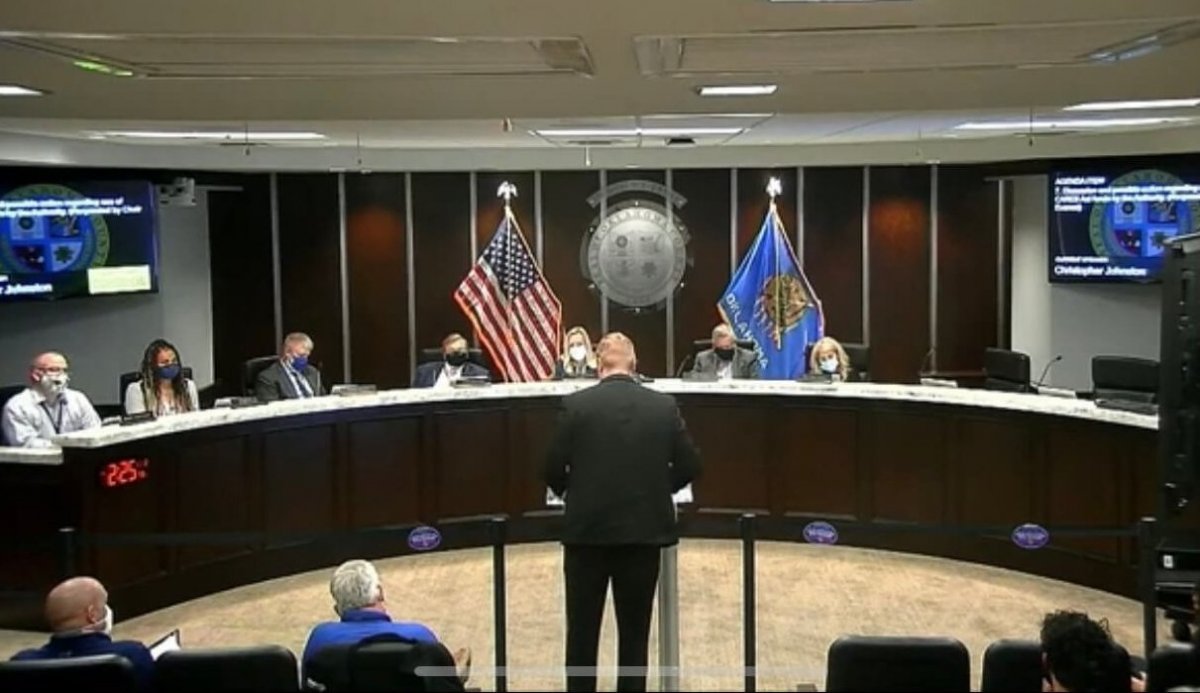A report by a consultant hired to evaluate operations and practices at the Oklahoma County Jail found problems with staff training, placement of the jail’s medical unit and its booking process.
The report, created by David Parker, also provides a series of more than two dozen recommendations he said could improve the jail’s operations.
Parker has nearly 40 years of experience with jails and prisons. He previously worked as the administrator of Tulsa County’s jail and with the Oklahoma Department of Corrections. Parker’s LinkedIn profile says he has been a consultant since March, and the Oklahoma County Criminal Justice Authority — colloquially called the “jail trust” — paid Parker $11,265 for the 160-hour study.
In the beginning of Parker’s 15-page report — the version of which embedded below is an unedited draft, according to Parker — he wrote that the Oklahoma County Jail has long been a subject of public discussion.
Stakeholders will agree the jail has long been a focal point of controversy and continuous filler for the local media,” he wrote. “We live in a time of instant gratification and transparency, thanks to the multitude of platforms available at a moment’s notice. This is both an opportunity and a curse depending on whose eyes you are looking through.”
Parker added that media often provide citizens singular versions of what is happening at the jail and that all “stakeholders,” including the public, should be informed.
“I have witnessed over the years a political tear in the operations as a stakeholder while residing in Edmond,” he wrote. “More recently I have witnessed fractures up close that compound the growth and development of the jail. Having documented these observations, I am contractually bound to offer suggestions for a solution. I will share those throughout this report.”
Operational culture the biggest challenge
In his report (embedded below), Parker wrote that he observed jail staff who often cannot identify the jail’s current policies. He also said some supervisors have created what he called “empires” within the jail.
“Change is often difficult for the staff who are affected directly and often do not have the insight or development to articulate from every angle,” he wrote. “Changing the operational culture at the jail will be your single greatest challenge while it is the most urgent need. Staff are the boots on the ground who make or hinder change.”
In another part of the report, Parker said he often identified too many supervisors present at one time.
“When looking at staffing there are instances where too many supervisors are present and you find, for lack of a better term, ’empires’ have been built throughout the jail,” he wrote. “Areas become overtly focused on just one area or task and lose track of the common goal if everyone has the same set of ‘Goals and Objectives’. This is something that evolves over a period, not a new development under the trust’s tenure.”
Parker said the jail’s current system is outmoded, like many others facilities around the country.
“When looking at the classification process in the Oklahoma County Jail I find with all jails the classification system is an old system that relies heavily on the opinion of an individual,” he said. “That individual is usually an entry level or lower ranked employee. That in addition to the computer-based program they implement an assortment of unofficial classification steps. When questioned why those steps were implemented, none could articulate why they were doing it or who even initiated the steps.”
Parker wrote that the current booking process is not efficient and leads to empty cells, while others have two or three detainees inside.
“The classification officers I had discussions with indicated they ‘only classify who is brought to them,'” Parker wrote. “This is another example of the ’empires’ that have been built over the jail’s existence. Classification Officers need to be retrieving all booking files instantly once mug shots and prints are completed. Then moved to an assigned cell without delay. The current method of classification creates secondary problems. By classifying using some of the additional what I call ‘that’s just the way we do it steps’ you create staffing problems. There were multiple open bunks and even cells throughout the jail created by this operational method.”
Lockdowns and vermin

Parker found problems with the jail’s practice of keeping inmates inside their cells for most of the day, which he said is common in many carceral facilities. He said the jail’s practices were “sporadic” and “without any measurability.” He added that lockdown facilities are antiquated.
“The days of running just a lockdown facility have passed,” he wrote. “A modern facility that stays out of the courts must be multi-faceted. Modern jails address mental health housing, restrictive housing, juvenile housing, maternity housing, infirmed housing, veteran housing, LGTBQ+ housing, protective housing, detox housing all with measurable systems ensuring safety, security, programs, and treatment, with policy requirements as a beginning.”
Jail trust member Sue Ann Arnall requested Parker’s study. She has long made direct supervision — where detainees are allowed out of their cells and into common areas for most of the day — a primary goal when it comes to improving the troubled jail.
“I think it’s cruel and inhumane to keep people in their cell for 18 to 20 hours a day,” Arnall told NonDoc earlier this year. “The next thing I’d like to see would be to get them more freedom of movement.”
Reached recently, Arnall declined to comment on Parker’s report, citing the announced grand jury investigation of the jail’s operations and the trust.
Parker wrote that some detainees decline mattresses because they are a haven for bed bugs.
“I witnessed detainees without a mattress or portable bunks,” he wrote. “When questioning the detainees about the reasoning behind them not having either a mattress or portable bunk, the reply was unanimous. They choose not to have either because the bugs used them for shelter. This is a quality of life and condition of confinement problem. While a solution is being developed, urgency should be applied.”
Breaks and leisure items
Parker observed that some jail staff did not receive adequate breaks while others worked in areas that included potential distractions.
“When interviewed, many staff assigned to a Pod indicated they rarely got to take a break,” he wrote. “I have viewed many of the same employees on break who are not confined to a Pod, however. This may be an area for review for consistency. Some staff indicated it contributed to the overall workplace environment.”
At the same time, Parker questioned the presence of leisure items in the workplace.
“There were occasions when touring areas of the jail employees were occupied with items that potentially could divert their attention from observing the jail’s environment,” he wrote. “Books, puzzles, cellular phones, and artwork are some examples. On the best of days, a detention facility requires all who enter to be vigilant.”
Follow @NonDocMedia on:
Parker challenges perception of staffing problem
Parker reported that staff he spoke to at the jail attributed most of the jail’s problems to a lack of staff, but he disagrees.
“Among staff the consensus is ‘every issue that transpires in the jail can be traced to staff shortages,” he wrote. “I found that to be 100% true among every staff member of the rank of captain to members of the academy class I met. That proves the jail training is contributing to the theory that the number one problem is directly caused by not enough staff. In my observation and professional opinion, the staffing numbers are as good as I have seen in Oklahoma.”
Staffing levels have been cited publicly as a factor in a variety of Oklahoma County Jail issues, including a March incident where a staff member was taken hostage and a detainee was fatally shot while holding him at knife-point.
“So, if you have ratios as good or greater than the state average; is it possible they are not being used in the most efficient roster scheme or posting available?” Parker asked.
Jail administrator responds
In an interview with NonDoc, Oklahoma County Jail administrator Greg Williams said he agreed with much of Parker’s report, and he said jail staff have already been implementing some of the suggestions. The trust hired Williams to run the jail’s day-to-day operations last year.
“There were several things that he brought up,” Williams said. “Bringing people in from the outside is very good. I’m glad we did it. It’s a different perspective. As we started rebuilding the operations at the detention center, we didn’t want to overlook anything. It confirmed a lot of what we suspected, and a lot of work we had started, but he brought some new insight.”
RELATED
Long called ‘deplorable,’ the Oklahoma County Jail reaches a crossroads by Matt Patterson
Williams disagreed with Parker’s statements on staffing. Williams said several other Oklahoma County Jail studies have been conducted that contradict Parker’s view.
“There’s been lots of staffing studies done here at the detention center since it opened,” Williams said. “I’ve seen some that date back to 2008, 2011, 2014, and he’s the very first person that has thought there was sufficient staff here.”
Currently, the jail has about 340 to 350 staff members, he said.
Williams said Parker’s recommendation on where to put the jail’s medical unit was among the most helpful aspects of the new report. Currently, the jail’s medical unit is on the 13th floor, which can make accessing detainees in need of medical attention problematic for first responders.
“That has not ever really worked out well,” Williams said of the medical unit’s current location. “I had been looking at an area that I was going to turn into medical, and he kind of flipped it upside down and said let’s move the intake into the area I was looking at and let’s put medical into the intake area. That was a new approach that I thought made some sense.”
Williams said bids are being taken on remodeling work that would need to be done to facilitate the recommendation.
While Parker recommended more in-person training, Williams said there is room for online training, which he said suits a younger generation of recruits.
“I think even universities and career techs have changed,” Williams said. “The old school is that class has to be in person, and I don’t think that is necessarily proven by best practices and data in the field. A lot of the younger people hired, they’re used to a non-instructor type training modality. Certainly some things have to be in person, like defensive tactics and emergency response.”
Final report on CJAC study coming up

Parker’s report is not the only recent study conducted on the jail. The Oklahoma County Criminal Justice Advisory Council will see the findings of a study conducted by FSB Architects and Engineers on three options for the jail’s future that include an entirely new facility, renovation of the current facility, or construction of an annex to provide additional space.
CJAC is an independent committee that assesses the community’s criminal justice system and provides recommendations on how to improve it. Part of that mission includes the jail.
CJAC executive director Tim Tardibono said FSB will provide an update on its current study at a public forum from 7 p.m. to 8:30 p.m. Thursday, Oct. 7, at the Cole Community Center, 4400 NW Expressway.
CJAC will hold its next meeting at 3 p.m. Thursday, Oct. 21, at NorthCare, 2617 General Pershing Blvd. in Oklahoma City. Tadibono said the final three options will be presented by FSB to CJAC at that time.
On Nov. 18, CJAC’s recommendations will be presented to the Oklahoma County Commissioners and jail trust for a final decision.
Read the full Parker report
(Clarification: This article was updated at 6 p.m. Thursday, Oct. 7, to correct a typo in one reference to Parker’s last name and to reference the above PDF as an unedited draft.)























